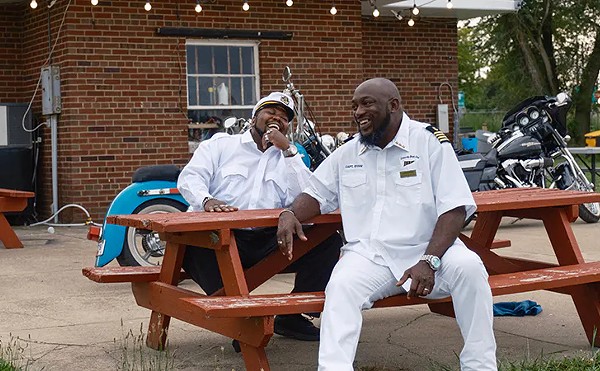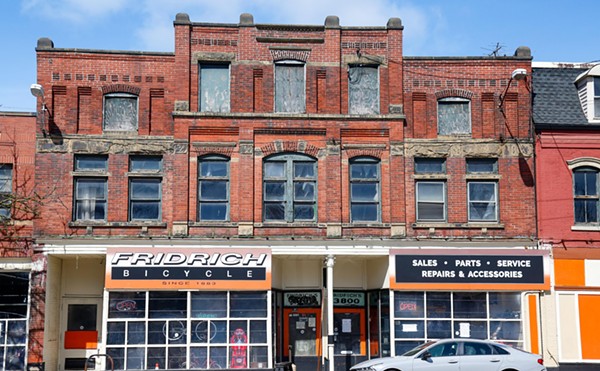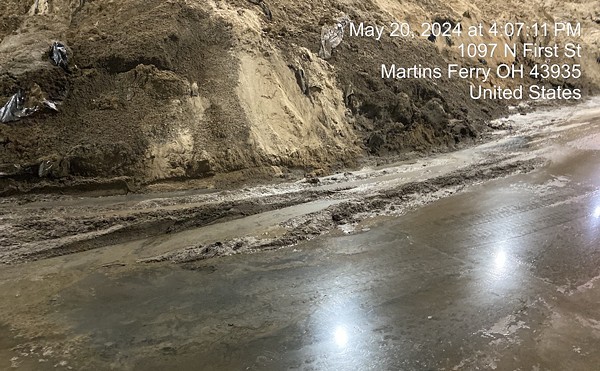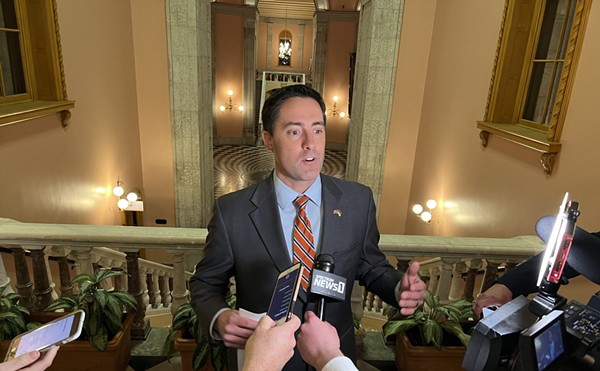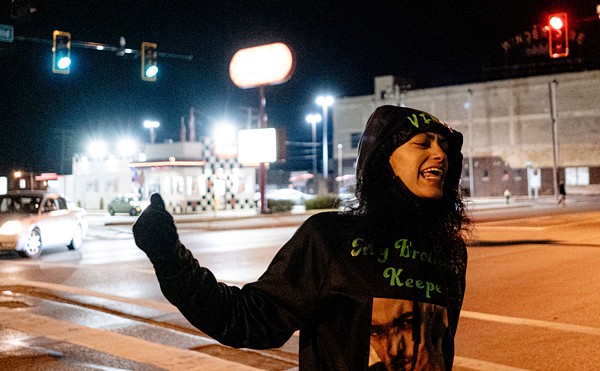Review: "A Strange Holiday," An Exhibition of Artwork Centered on Sam Sheppard
By Joseph Clark on Mon, Sep 22, 2014 at 12:49 pm
[
{
"name": "Ad - NativeInline - Injected",
"component": "38482495",
"insertPoint": "3",
"requiredCountToDisplay": "5"
},{
"name": "Real 1 Player (r2) - Inline",
"component": "38482494",
"insertPoint": "2/3",
"requiredCountToDisplay": "9"
}
]
On July 30, 1954, the Cleveland Press ran the headline "WHY ISN'T SAM SHEPPARD IN JAIL?" For weeks, the paper had been urging police to pursue the physician in connection with the July 4 murder of Marilyn Reese Sheppard, his wife. Despite Sheppard’s claims of having grappled with a “bushy-haired man,” no other suspects had emerged. The absence of any signs of a break-in at the couple’s home implicated the doctor.
Hours after the Press’ headline ran, Sheppard was arrested at his parents’ Bay Village home.
Sixty years later, that house is the site of Bay Arts’ Sullivan Gallery. Now, the art space is utilizing its coincidental ties to the case to mark its grim anniversary. The exhibition “A Strange Holiday," which runs through Sept. 27, has recruited 13 artists for an “aesthetic examination” of the trial of Sam Sheppard.
Aggressive media coverage of Sheppard’s case did not begin or end with the Press’ cajoling headline. Local media put Marilyn’s killing on the front page immediately, and kept it there for weeks. National and international followed their lead. Damning editorials ran alongside everything from accounts of the doctor’s philandering to the names and addresses of his trail’s jurors. When the U.S. Supreme Court overturned Shepherd’s conviction in 1966, the judiciary cited media influence as a contaminant to the verdict.
Many artists contributing to “Strange Holiday” have sensibilities taking after Pop Art, so it is unsurprising that many produced commentaries on the relentless and often salacious coverage of the case, rather than the murder itself.
This emphasis was intentional. The Kenneth Paul Lesko’s director, Ross Lesko, curated “Strange Holiday” along with Eileen Stockdale, director of the Sullivan Gallery. About eighteen months ago, the pair began brainstorming an exhibit on the Sheppard case—a round-number anniversary was coming up, offering a once-in-a-decade chance to capitalize on Bay Arts’ place in local history.
The topic was irresistible, but Lesko said he struggled with reservations. Developing the show, he wanted to avoid the sensationalism characterizing many retellings of the tragedy. To this end, he approached artists he had worked with before. (Attendees to the Lesko’s annual “Cinema” exhibitions will recognize names and styles.)
Lesko said that he invited people he trusted would exercise empathy while not “censoring” themselves with safe art. Many attempted to do this by commenting not on the murder itself, but on the cultural phenomena that sprung up around it.
For example, in “Sphinx” by the Brazilian artist called Atomic Ghost, Sheppard, clad in a crisp suit and eye-masking shades, towers over hilly wastelands. In the foreground, a tiny pair of figures—a woman in 50’s dress and a boy sitting cross-legged—stare at the looming presence. Sheppard’s sharp dress and gigantism symbolize the strange celebrity thrust on him. The dwarfed woman and child stand for the doctor’s wife and son, Sam Reese Sheppard, two victims of the crime who are often overshadowed by the photogenic suspect.
Eric Fracassi’s collage “True Crime” combines photos of the Sheppards with pulp novel cover art, comic book onomatopoeia (BAM! WHAM!), American flags, and red and blue splatters. Sheppard’s mug shot is recolored with opaque blues and reds, mimicking Shepard Fairey’s Obama HOPE poster. Slickly packaged sensation bleeds into trashy fiction, until they can’t be distinguished.
Some might find the artists’ self-conscious detachment from the crime itself distasteful. After all, there are still people alive who knew and loved Marilyn, including her son.
No pieces memorialize Marilyn specifically. However, some speak to the anger and confusion observers of her case experience. Moe Phoe’s “Bushy-Haired Man” reimagines the assailant Dr. Shepherd described. The hypothetical killer is represented by a screen capture of the vertically-maned Jack Nance, the lead actor of David Lynch’s Eraserhead. Nance’s face is obscured by a layout of the Sheppard home used in police investigations, and Col. Mustard’s card from Clue.
The bushy-haired man’s covered face jolts the heart. He turns toward us, might even be looking at us. Yet his features remain as hidden as if he had no face at all. The images from Lynch’s famously opaque film and the whodunit board game mockingly draw attention to our ignorance of him, and the Sheppard murder. We squirm at the reminder.
At the very least, “Strange Holiday” avoids going wrong in some of the ways such a show easily could. No one here romanticizes Dr. Sheppard, and only a few polemicize. (In Seattle artist Troy Gua’s piece “The Accused,” the doctor’s face is superimposed over that of O.J. Simpson.)
But does the show avoid voyeurism? As important as this question is, an attendee to the exhibit might profit more from asking, Do I? The exhibit’s critique of crime-driven infotainment implicitly criticizes the audiences who feed such coverage, and we might be better people for heeding it.
“A Strange Holiday” will run through September 27 at Bay Arts, 28795 Lake Rd., Bay Village. For more information, call 440-871-6543 or go to bayarts.net.
Tags:
SCENE Supporters make it possible to tell the Cleveland stories you won’t find elsewhere.
Become a supporter today.
About The Author
Scroll to read more Cleveland News articles
Newsletters
Join Cleveland Scene Newsletters
Subscribe now to get the latest news delivered right to your inbox.




